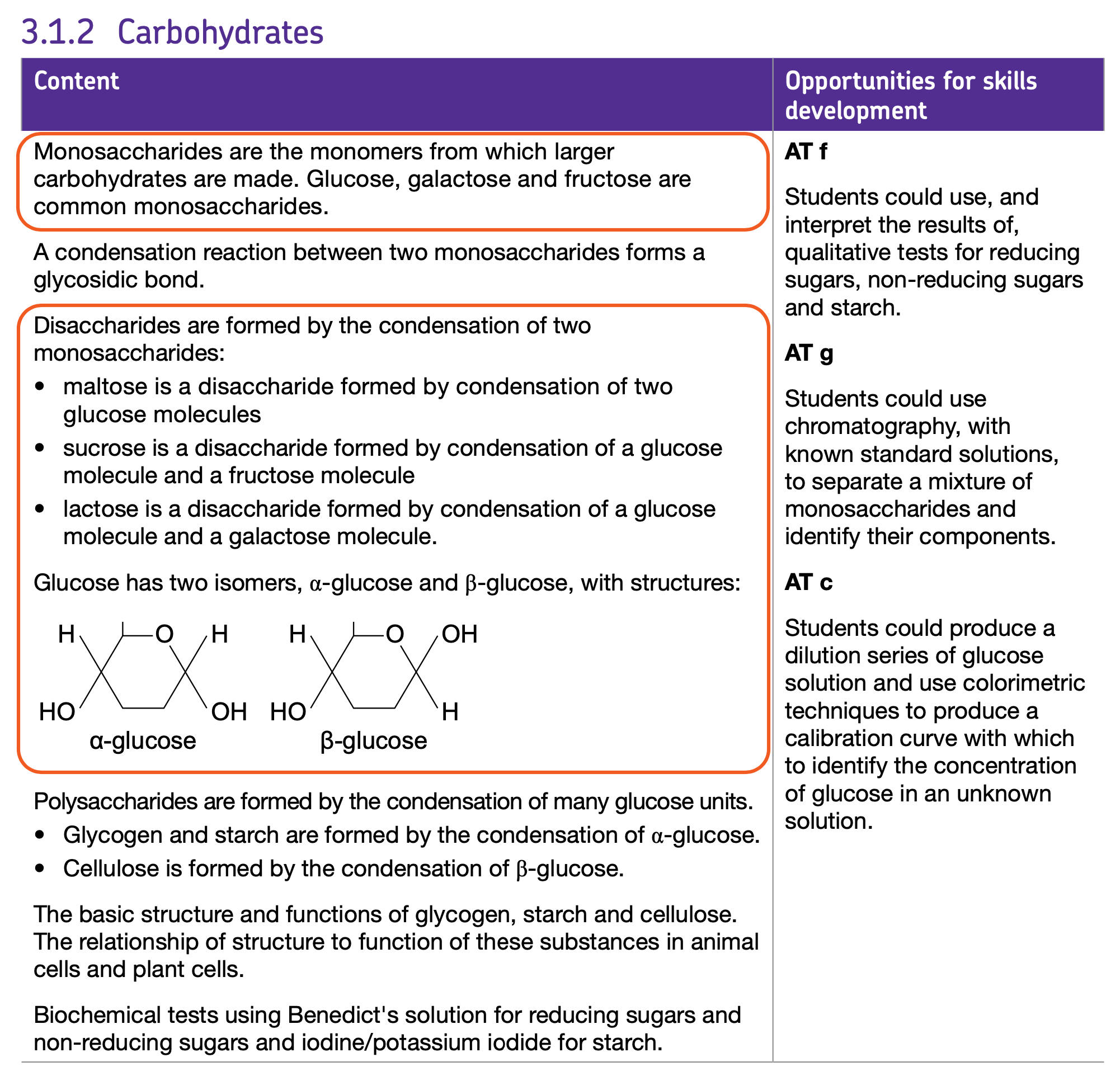LEARN & MAKE NOTES
A concise video lesson covering everything you need to know as quickly as possible
TEST YOUR KNOWLEDGE
Use the quiz to check your knowledge and as a way of strengthening your learning
TEST YOUR UNDERSTANDING
This is what you’re aiming for – can you apply your knowledge to an exam question?
VIDEO TRANSCRIPT
Monosaccharides & Disaccharides – TRANSCRIPT
Okay, well the words are going to give us a lot of clues, here, as always in biology: So ‘mono’ is one, ‘di’ is two so a monosaccharide plus a monosaccharide equals a disaccharide. And we’re going to look at the ones that you need to know for the course, so, conveniently they all contain glucose.
So, we have:
glucose plus glucose is going to give us a molecule of (and, again, see if you can get these before I write them down) the disaccharide which is maltose and, again, be really careful with your O’s and your A’s if we’re involving enzymes at all.
We also have glucose, reacted with fructose, and this gives us the disaccharide called sucrose.
And finally, you have glucose plus galactose which gives us the disaccharide of lactose. Obviously, the clue is very much in the name, with galactose forming lactose.
So the three disaccharides that you need to remember are maltose, sucrose and lactose. You need to know which monomers make them up: So, glucose and glucose. (Maybe let’s put some pluses in here). Nice and easy so far.
Okay. Let’s look at glucose in a little bit more detail.
So you probably know from GCSE: It has six carbon atoms, so we therefore call it a hexose (which is a generic name for a carbohydrate). ‘Ose’ tells us it’s a carbohydrate: if it’s an ‘ose’ it’s a sugar, it’s therefore a carbohydrate and hex just means six carbon atoms.
It contains the elements carbon, hydrogen and oxygen, often abbreviated to CHO. In the exam, you are allowed to use abbreviations for elements. If it’s one of the known…well, if you know it, then it’s likely to be accepted, but you can’t make them up. They have to be the official ones.
When they join together, or when any carbohydrates join together, we form a glycosidic bond. I think I’m actually going to put that information over here. I’m gonna say that it has two forms, which are alpha glucose and beta glucose. That’s my version of the Greek letter Alpha.
I’m going to draw the generic structure: the bits that are exactly the same between the two, in the centre, here, in full atomic detail. I get asked for this – It’s not something that you get asked to draw in the exam. If you check your copy of the specification, there will be the molecule of glucose and it will show you how the exam board represent it in the spec and that’s the level of detail they’re looking for, but I’m just doing this middle version just so that there’s no confusion about what I mean when I draw the slightly more simplified version.
So, probably the easiest place to start with your molecular glucose is the oxygen atom which is in the ring. It’s a hexagonal ring. So, that gives us our central structure. We’re going to have carbons at all the other points of the hexagon. But, obviously, we’ve got one, two, three, four, five carbon atoms because one of the hexagonal sides is taken up by the oxygen. So there is an additional carbon atom off the top and this is just a carbon with hydrogen, hydrogen, oxygen, and it’s nearly always… I literally couldn’t find the example online of it drawn out in full… So it’s nearly always written as CH2OH on the top, there. And again, this is the mega mega detailed version that you don’t really need to know. And then, these carbons I’m going to leave empty for reasons that we’re going to see in just a moment. And then we have a hydrogen here, with an OH, here. And again, this is the detail that we don’t really require in the exam, but I’m drawing it in because I get asked for it.
And then this carbon is going to make two bonds. Every carbon atom always makes four covalent bonds. So you can see this one has got one, two, three, four. This one has got one, two, three, four, and that’s always the case in organic chemistry. And that’s that.
Okay, so then we’ve got what goes on here and here, well, this is going to be basically, this is the difference between alpha and beta glucose. I’m just gonna put them in as empty boxes right now.
The other thing I’m going to delve into the detail here is that we’re going to number these carbon atoms, which occasionally we touch upon when we’re looking at how the bonds form. So, we simply are going to give them a number… full A level chemistry will tell you exactly how you pick which one is carbon atom number one, but I’m gonna tell you that this is carbon atom number one carbon atom number two, three, four. This one is number five and then this one is number six.
So, if I said which one is carbon atom number four, it is that one right there. Okay, so now I’m going to draw alpha glucose and beta glucose. And I can draw the simplified structure which is the one that if you get asked to draw it, again, very unlikely that ever comes up, that this is the one that you would draw.
So now I’m going to simplify this diagram here and just have it as my oxygen.
Okay, so now, I guess I should put on my alpha glucose (this is obviously what’s going on inside these boxes here). We have hydrogen on the top and OHs on the bottom. And we can see here, if I were to just accentuate where the carbon atoms are (and this is why I’ve drawn the full structure out), we’d have a carbon atom here, carbon atom here, here, here and on the end up here as well. That’s where our six carbon atoms would be. But again, it’s normally just drawn as straight lines – standard practice in organic chemistry.
The way I like to remember this is: we have our Ho Ho Ho’s, our OHs, our hydroxide groups. I’m going to say… I use my alpha…So, these are A’s: Santa, that says, Ho Ho, and he goes down the chimney. So, that tells us that our OH groups are on the bottom on both sides in alpha glucose. This is by far the most common one that you’re going to come across. If people just refer to glucose, they’re generally referring to alpha glucose, and this is involved in, therefore, maltose, sucrose, lactose, starch, and glycogen. So, they’re our disaccharides, and then our polymers that contain alpha glucose are starch, which again is a mixture of amylose and amylopectin. I’ll go into that in more detail in the Polymers of Carbohydrates. Starch and Glycogen.
Now, beta glucose, on the other hand, is only found in cellulose.
And again, can you try and sketch out the structure before I draw it for you? And start with our oxygen…Okay, so so far it’s identical. But, what we’re going to flip here is the up-down direction of the hydroxide, the OH, and the hydrogen on the right-hand side, so next to carbon atom 1. If we remember carbon atom 1, that’s the one that’s flipped upside down. And so, if we remember that Santa goes down the chimney, and therefore we’ve got both OH groups, OH, Ho Ho, on the bottom, then beta glucose has one of them flipped, and one of the OHs is on the top.
And I’m just going to add in a tiny little detail about the glycosidic bonding. So, this is a bond formed by a condensation reaction joining molecules in a carbohydrate.
So, if it’s a bond joining carbohydrates together, you can bet your bottom dollar it’s a glycosidic bond. That’s a rule. Typically, we’re going to sort of draw it as an abbreviation, and it’s going to look like this: carbon atom, oxygen atom, carbon atom. If we were to draw that in full detail, we would end up with something joined onto the carbon atom here, and then we’re going to end up with our oxygen and then our carbon. And then that’s joining on somewhere else, and we might have a hydrogen up here and a hydrogen down here. To be honest, whether the hydrogens go on the top or the bottom isn’t particularly important. You’re never going to get asked to draw a glycosidic bond in this detail. It’s nearly always going to be recognizing one in the exam or just simply knowing that the bonds in a carbohydrate are glycosidic bonds.
Enzymes, Proteins, Graph interpretation
A different take on a ‘calculating rates’ style question in the middle of some fairly straightforward enzyme content recall. A confident understanding of enzymes is crucial.
QUESTION MARK SCHEME
